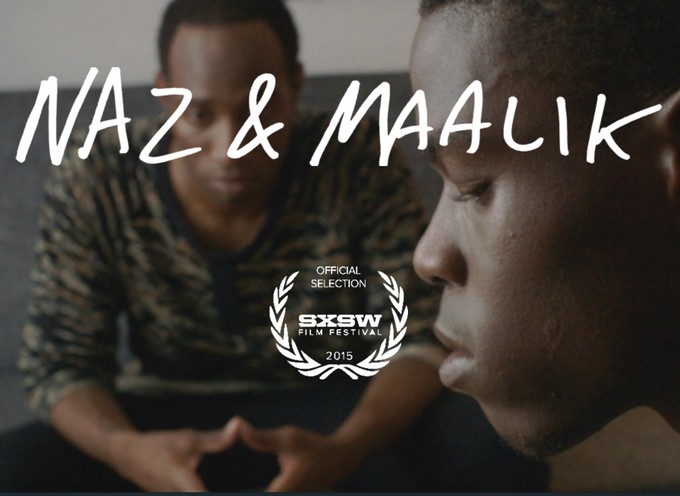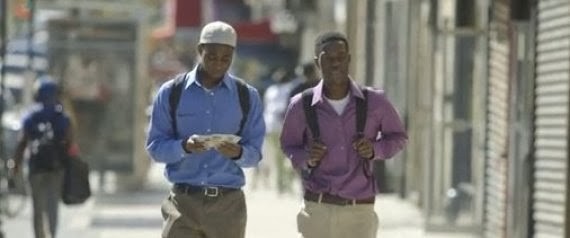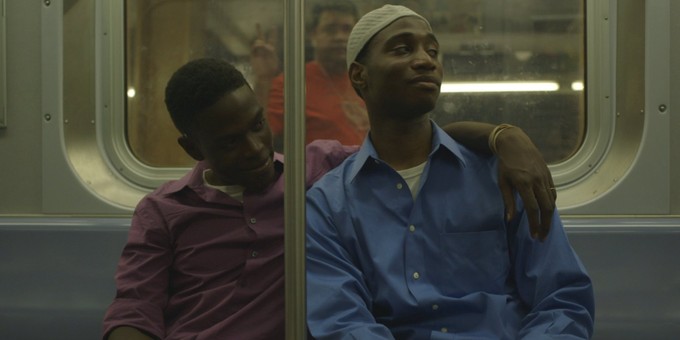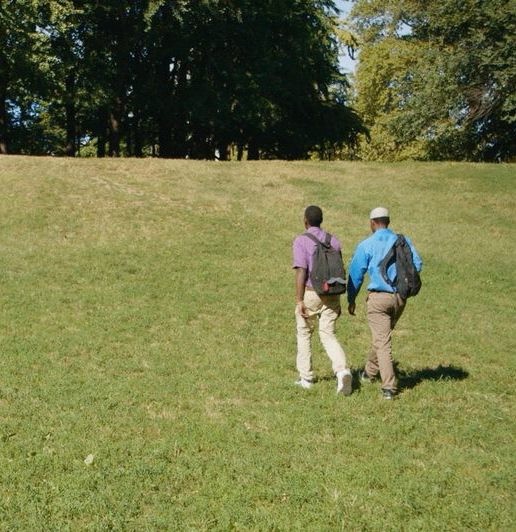
Jay Dockendorf has done something special with NAZ & MAALIK. By choosing to tell the story of two Muslim boys traversing around Brooklyn, he’s shining a light on an experience that most people in the U.S. will never personally witness or endure. He does so using two open, brave actors, Curtiss Cook Jr. and Kerwin Johnson Jr., and a day-in-the-life structure not unlike those found in DO THE RIGHT THING and Richard Linklater movies such as SLACKER, DAZED AND CONFUSED, and the BEFORE trilogy. That he chose to tackle such loaded subjects as Islamophobia, homophobia, and racism in post-9/11 New York City, but that the film works as an emotional narrative without the sociopolitical aspect is simply remarkable. It’s a subtle, human project, and the trio of Dockendorf and his actors are central to everything that works about the film.
The trio sat with me, and told me their thoughts on why the story needed to be told, and, of course, the practicalities of shooting a feature film in a big city on a minuscule budget. And how to wrangle a live chicken.

VINYARD: Let me just get each of your thoughts on why you wanted to do the project.
CURTISS: Why I wanted to do the project. The reason I wanted to do the project was- not simply a no-brainer, but at the same time it was. I went back and forth with Jay, nothing bad or anything like that, it was just about, “What is the purpose of making this movie, what is it about?” And what I was told at that time totally sufficed: “We are making a movie about life, about these two kids who go through the same things you go through, do the same things as you, mostly, and have different things happen to them ‘cause of what they choose to follow, or what their parents chose for them to follow.” I paid attention to that, and I just sunk with the part that these kids are me, this kid is me. Why would I not want to do this? This is the epitome of acting for me right now. I get to do something that challenges myself, and I get to do something that is myself in a way too, you know? It was a no-brainer.
KERWIN: To reiterate what Curtis said, it was life. It was just a great story, one that I thought needed to be told. In thinking back, I was glad that I had the opportunity to be a part of it.
VINYARD: And Jay, when you were conceiving the project, what was your thesis, so to speak?
JAY: My thesis was that I’ve seen thousands of movies about this, and what I hadn’t seen, which was the reason I made this movie, were about queer characters, about characters that were outside of the box of who was standard. Non-white characters, characters with diverse backgrounds of al kinds who are experiencing life and the struggles of life in America on their own times, not being forced into some kind of paradigm or lifestyle. And I just thought these kinds of films can be revelatory, straight advocacy without being the kind of film that feels like a public service announcement. Movies like Ang Lee’s THE WEDDING BAND???, that really stuck out to me. Movies like PARIS IS BURNING, movies like SLACKER, DO THE RIGHT THING, SHE’S GOTTA HAVE IT, all of these films. It just felt like the most electric, the most real.
It’s not like that thought occurred to me out of the blue. I’d just moved to New York, and right before I saw those films- I saw most of those films while I was hatching this project- I lived with this really brilliant Muslim scholar of early Koranic history. Graduate student, about 28, 29, living in Bed-Stuy, which is one of the most historic black neighborhoods. There’s a huge Muslim population there that brings a big life to the streets. You really see them around, and you really get an idea of what it’s like to live in their neighborhood. We lived there for a month, but in that month, I got to know my roommate on an intellectual and emotional basis. He wasn’t out to his family, he was closeted, but he was out to his friends and to me, and we talked about the tensions there, and the realities of his life were so dramatic and so interesting and so relatable. I asked if I could interview him- I wasn’t going to make the film, I didn’t have his permission to make the film. I wasn’t even sure I wanted to make a film- I also make documentaries- I just knew that I had really met somebody who fit my definition of what an interesting protagonist or hero really amounts to. Once we had that conversation, I got to know him.
These two characters started to formulate in my mind. He was 28, as I said, much older. But these guys were teenagers.
VINYARD: Did he expose you to a community similar to the one you portrayed?
JAY: Definitely. We went to a few mosques together. The one I portrayed is one I think is pourous, welcoming, sacred, and moving. I was really moved by seeing…I went to the NYU interfaith center, and they have services for the Islamic community on Friday. We went, and I saw a caucasian man convert to Islam for love. He was about to marry a Middle Eastern woman. That service was just beautiful. Thousand people coming together, and seeing that all happen. I’m not particularly one faith over the other, but I have a lot of respect for meditation and for prayer. I really wanted to honor that. That’s why we have that scene in the mosque, which I think is the most beautiful scene in the movie, personally. I’m really happy with the way Kerwin and Curtiss look when they’re praying. We had an actual Imam read that scene, and the speech that he gives is verbatim a speech that I know has been given several times by several sermon givers. Not everybody who gives a sermon is an Imam.
Exposing ourselves to that was one thing. On the other hand, I had to create these characters. I never met someone who fit all of the bills. I met some formerly closeted Muslims, I met some black Muslims, and closeted men, and formerly closeted teens, I met all these types simultaneously. We kind of had to mate that together, piecing togther the other pieces of the puzzle of who these guys were. And then who they really became was a product of taking my original roommate, and kind of splitting his experience into two halves. He was about to come out to his family, he’s out to his family now. He went 10 more years after he was the age of Naz and Maalik without coming out. I think at the end of the move, Naz is probably not gonna come out to his family. Maalik is about to, he’s about to ruin his mom’s birthday.
My vision was shuttering that off into two separate characters. That was the project.
VINYARD: You mentioned DO THE RIGHT THING and SLACKER before, and the film has a similar structure in terms that it’s over the course of one day. Why did you choose that structure? Why did you choose to tell the story in that way?
JAY: I think I chose that structure because I feel like that structure is representative of the tone and the voice I wanted the film to have. I wanted the film to be representational, not particularly perscriptive or over-the-top in any way. I guess if you take characters like this, characters whose lives are so often portrayed as one thing or the other, and you give yourself a massive time scale, 1. that’s hard to execute, 2. it doesn’t seem psychological very real. Seeing them in their school then they’re making out, then they’re graduating, then they’re in college, I always feel like those movies don’t necessarily hit me the right way. In any way, I was just going with what I knew worked. Probing, psychological portraits with philosophical dialogue that revealed what these characters were really thinking about. I like the day in the life story, I’m not really sure why. It was easy for us to make. That was another thing. I saw RUSSIAN ARK a few months before I made this film, and remember feeling egotistical or insane, I thought maybe we could make the film in a single continuous shot as they move through New York, or something like that. That seemed like a formal experiment. I wanted to do some formal experimentation like they do in all my favorite films. There’s always something they try and do originally with the camera. We didn’t do that, but we did what we did.

VINYARD: (to Curtiss and Kerwin) This question is for you guys. Obviously, your relationship is the core of the movie. It is the movie. You guys have a very natural chemistry, which is crucial. Was there a rehearsal process? Did you guys know each other beforehand? How did you guys get to know each other and achieve that sort of interplay? Also, how much did you guys improvise? Because it seems very natural, the dialogue.
KERWIN: We did a lot of things. Jay gave us a lot of freedom to try different things. He asked us, “What do you think about this? What do you think about that?” Always asking for our input, which really helped. But I did not know Curtiss previously before the film. I’d say what really built that chemistry was him, Jay, and I going out, doing the auditions, doing the rehearsals together. Also, Curtiss is a really cool guy. Easy to talk to. That really helped.
CURTISS: We just got to rehearsing this thing. Jay was really cool, I really respect that he did that, ‘cause I love rehearsals man. I love rehearsing, I love discovering inside, and I love that Jay came into it with an open mind. It was his story more than it is mine, in the initial place he was at. So him being willing to take us on, allowing us to come in and help him with this project, and then being able to sit back and listen to our thoughts and ideas and actually use some of them, and actually incorporate them into the film and let them help shape the film, let them help shape the idea that he envisioned and was trying to throw out, I dunno brah. I got real lucky with that, man.
JAY: We rehearsed a lot on location, over several days. We rehearsed for about three weeks. We broke it down. It’s not like we were so ambitious every single day. We learned about it, and we started small, maybe a whole day on that hill in Fort Green when they’re walking around. Go out to the Fulton Mall, and they’d sell with real people on the street before we started shooting. I didn’t want to have that on camera, I didn’t want to have an experience with the BORAT style. If people were in the film, I didn’t want to have to ask them for permission later. I love rehearsing on location. I want to do it again and again. I think rehearsal is the only way to get great performances that I know.
VINYARD: What was it like finding those locations, and was there any trouble? You shot on the subway…
JAY: Finding locations was kind of easy for us, because once I had a loose idea of what the story was, I just followed where the characters would’ve naturally gone, and then brought them back home again. I knew I wanted them to start at home and end up home at the end of this thing. The path they selected was the path we took. You can kinda walk that, more or less. Subway was easy because, right now in New York, you can film on a subway without lights, without a tripod, without reflectors, without any grip equipment. You’re just another tourist with a camera. Or another creep with a camera.
CURTISS: Without making a scene, no pun intended. Oh! Oh! Pat yourself on the back, Curtiss, for that one!
JAY: That was that. I think there was a law that was passed after 9/11 that said you can’t film on a subway full stop, because they didn’t want people scouting the infrastructure of the city or whatever. I didn’t go back to the history books to see what the previous laws were like, but that what was we talked about on set. That’s what we told ourselves, at least. That this is a post-9/11 film, with post-9/11 laws, and some of them haven’t changed. Surveillance is ongoing. What else was a person going to write about during this? If you were living in that neighborhood, there was nothing else that was as interesting as this. So I’m really grateful that the two of them made the film with me if for all the reasons we just mentioned.
VINYARD: A lesser film would have probably used that post-9/11 paranoia that you’re referring to, and it probably would’ve gone to more extreme lengths with it. Some sort of accidental shooting, or the subplot with the FBI agent would’ve gotten more explosive and final, and not more naturalistic. Was there ever a desire for you to kind of…blow things up, so to speak?
JAY: No there wasn’t. I always wanted the finale to be about something much more psychedelic than that, something that reflected their interiority. The things that happen in the second half of the movie needed to be about them. It was always going to be a character study, the explosion of personalities colliding. The FBI agent thing was kind of a formalistic device. I wanted to pay homage the traditional cops-and-robbers, good guys and bad guys, flip the paradigm on its head. You can see where that took me. To be honest, to get that kind of thing really right, to get the feeling of a policewoman or man walking down the street with their gun drawn, is kind slick in a different way, so we were trying to have a little bit of fun with that, and fold that into the psychedelic nature of their minds. Not that these kids are on drugs, or anything like that. You don’t need drugs to have a psychedelic experience.
CURTISS: I don’t need drugs, man, I’m on life!
JAY: I think you are! I think you’re a little crazy when you’re a teenager. I’d like to think that she’s not even an FBI agent, she’s just some lady.
CURTISS: You might wanna make that movie man. M. Night Shyamalan, “I was never really an FBI agent!”
JAY: There’s a great movie called TAKING OFF, where you see the movie the first time you don’t realize, and then the second time you see it, you realize-
CURTISS: Whoa, whoa, whoa!
JAY: I won’t tell you the ending. TAKING OFF, it’s Milos Forman, his first English-language film. Set in Greenwich Village, 1970. It’s nuts. It’s about folk music, and these women folk singers, and who the parents of this girl who runs away. The girl doesn’t do anything that crazy, but the parents go NUTS. It’s like they’re chasing after her. I didn’t actually see the movie until I finished NAZ & MAALIK, but I kind of considered it a spiritual predecessor even though I didn’t see it until I was finished.

VINYARD: You describe the FBI agent as sort of a villain, and that she might have been a poser, and I think one of the thing that contributes to that is how natural the performance is. All the supporting characters in the movie, no matter how brief, have a natural sort of feel. How did you cast everybody?
JAY: It was a shotgun casting experience. The casting experience was crazy. It was almost so crazy, that I think we got lucky or played off the craziness. The casting experience was reflective of the way the movie kind of panned out. The two of them we cast in a very special way. We gave them sides, and had them read their lines, and figured out who might be A and who might be B. I say that, because I was calling their personalities A and B. I didn’t want to name the characters until we got a few days into it. Then all the supporting characters read. If they were a man, they read one monologue, the subway monologue, and if they were a woman, they read another monologue. We cast Sara individually, we cast Kala individually, but all the supporting characters, the people who show up briefly, they were reading just one of two possible sides. I just kind of saw their look, and felt they could act. If they could do anything with their monologue, I was sure I could work with them and put them in the movie. And they delivered, so I felt good about that. But I’m not sure you’re necessarily aware of how many people we pulled off the street. There are a lot of people who didn’t show up some days because there were so many roles, some people would be like, “What the hell, I’m not coming out to Brooklyn!” There were a few dudes who just didn’t show up, and we had to cast them from a guy who was walking by who was willing to work for four hours for 80 bucks or whatever it was. Just do it that way. That was really fun, and gave us a weird thrill. We kept it weird, man. The whole time, it was always like fun, and based on the rehearsal, I was confident with the two of them, so I was comfortable working with that third person ‘cause we had rehearsed so often. I usually played those roles when we were rehearsing, ‘cause I had to.
VINYARD: You had a live chicken.
JAY: Yes. No animals were harmed in the making of this movie. Apparently we’re not allowed to say that at the end of the movie ‘cause that phrase is copyrighted. Who the fuck cares? Imagine other ways of saying that. We should’ve just had a card that said, “We did not hurt the chicken.” We could’ve got around that. We didn’t throw it off the balcony. We didn’t eat it, we didn’t cook it. As far as we know, the chicken is alive and well. My girlfriend gave it back.
VINYARD: Was it hard to shoot it? Was it hard to control it?
JAY: No, the birds are really cool. I didn’t realize the chickens were kind of down with being handled. We thought we’d have to chase it around the room. It would run, and we’d chase behind it and we’d maybe get a shot of it clucking, but not really.
CURTISS: They were like New York pigeons.
JAY: The one thing we did have trouble shooting was we found this ledge that looks like a dramatic ledge for the chicken to walk off of, and the chicken was only stepping down like just it’s own height. It was totally comfortable doing it when it dropped down. It was like, “I’m fine, I’m here.” That was really thrilling. That was kind of the experience of the whole film that we all kind of got onboard with. I could not wait to bring the chicken on the set.
CURTISS: You lived with the chicken.
JAY: I lived with the chicken for three days. It was crazy.
VINYARD: Another thing I really liked about the movie was that even though it’s been 14 years since 9/11, the Islamophobia is still prevalent, albeit in a lot more subtle ways than you might’ve experienced immediately after. Why the decision to set it today instead of right after? How do you think it’s changed over the course of 14 years?
JAY: It’s good that there’s a net that catches really bad people who do bad things and hurt other people but I think today, people are a lot more calm about it and recognize that two guys walking down the street, they’re not doing anything wrong. The vast majority of Muslim people are honest, humanistic..that sounds kind of corny doesn’t it? But to answer your question, I just didn’t want to give a voice to the people who were spewing hate. To me, it’s just a better world when people aren’t looking sideways at everybody, and yet, you don’t want to minimize that until it’s no longer a reality, because it is. It’s what a person would experience now. There’s still guys infiltrating mosques, posing to be Islamic who are just stooges of the FBI and so on and so forth. Getting the balance right, to answer your question.
CURTISS: It was really bringing the B-side story. We keep hearing the mainstream side of it that gets people into a certain attitude about things, then there’s the other side, like “How did that come about? These things out here in the newspaper, alright, how did we get to that?” And then letting you judge that for yourself. How do you feel about that now? Now that you see it and know it a little bit, loosely, how do you see it? Do you want to do a little more research on it? Do you want to follow up on it? Do you want to read about some stuff? Do you want to experience it? Bringing attention, bringing awareness.
VINYARD: It’s even more scary, because it’s almost like instinctive to go after these kids. There’s not even that filter in her mind of like, “Should I do this? Is this racist? Is this Islamophobic?” It’s just kind of like protocol, like “Of course I’m gonna follow these guys.”
JAY: We had the opportunity to show more of her behind the scenes, but it’s almost better without it, because we didn’t want to give a lot of voice to that so it could read as protocol, read as automatic, and the systematic nature of what she’s doing would make more sense. We could’ve explained why she reasonably somewhat thought the kids were maybe involved in something. But we figure we’d let that float away, and let the kids proceed by, I guess.
